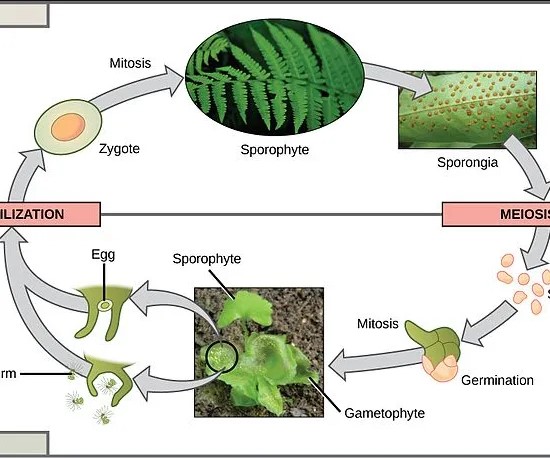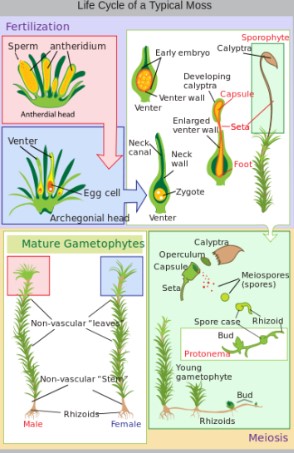Mosses and ferns, two distinct groups of plants, play crucial roles within their ecosystems, despite often being overlooked in favor of their larger, flowering counterparts. Both have thrived on Earth for millions of years, adapting to a wide range of environments. Their presence is not just a testament to the planet’s lush biodiversity but also to the intricate evolutionary paths that have shaped the plant kingdom.
Mosses are small, non-vascular plants that typically form dense green clumps or mats in damp, shaded environments. Ferns, on the other hand, are vascular plants that produce large leaves (fronds) and have a more complex life cycle involving distinct sporophyte and gametophyte stages. The primary difference between mosses and ferns lies in their size, structure, and reproductive methods, with ferns being larger and possessing a vascular system, unlike mosses.
These plants are not merely survivors from ancient times; they actively contribute to their ecosystems. Mosses aid in soil formation and moisture retention, while ferns can dominate understorey plant communities in forests, contributing significantly to biodiversity. Both groups have adapted to their environments in unique ways, showcasing a range of forms that vary from the tiny, cushion-like mosses to the large, leafy fronds of ferns.

Basic Characteristics
Moss Overview
Definition and General Description
Mosses are small, soft plants that are classified in the phylum Bryophyta. They lack vascular tissue that is common in other plants, making them simple in structure. Mosses usually form dense green clumps or mats in damp locations. They are non-flowering plants that play a fundamental role in their ecosystems, particularly in water retention and soil formation.
Habitat and Distribution
Mosses thrive in moist, shaded areas, but they can adapt to a variety of habitats, from forests and wetlands to urban areas like garden walls and rooftops. They are globally distributed, with species flourishing from the Antarctic to the Arctic. Their ability to survive in extreme conditions, from deserts to rainforests, showcases their adaptability.
Fern Overview
Definition and General Description
Ferns are vascular plants belonging to the division Pteridophyta. Unlike mosses, ferns have vascular tissue, which supports their larger size and complex structure. They produce distinctive fronds (leaves) and often have a rhizome rather than true roots. Ferns do not flower but reproduce through spores, setting them apart from flowering plants.
Habitat and Distribution
Ferns are found in a wide range of habitats, from dense rainforests to dry desert rock faces. They prefer humid, shaded environments but, like mosses, display a remarkable ability to adapt to various environmental conditions. Ferns are most diverse in the tropics, but many species are also found in temperate zones around the world.
Physical Differences
Moss Structure
Size and Shape
Mosses are generally small, often only a few centimeters tall, with some species forming mats or tufts on the ground or other surfaces. Their small size and lack of vascular tissue keep them close to the ground, where they can absorb moisture directly from their environment.
Leaf and Stem Characteristics
The leaves of mosses are simple, usually one cell thick, except at the midrib. They are attached to stems that are not true stems as seen in vascular plants but serve a similar function, supporting the leaves and reproductive structures. Mosses do not have roots but have rhizoids that anchor them to a substrate.
Fern Structure
Size and Shape
Ferns can vary greatly in size, from small, inch-tall species to those with fronds reaching several meters in length. Their structure is more complex than mosses, with a division between the rhizome (the root-like part) and the fronds.
Leaf (Frond) and Root Characteristics
The fronds of ferns are often large and divided, with a complex vascular system supporting them. This system allows ferns to grow much larger than mosses. The roots of ferns, originating from the rhizome, are true roots that absorb water and nutrients, unlike the rhizoids of mosses.
Reproduction Methods
Moss Reproduction
Asexual Reproduction
Mosses can reproduce asexually through fragmentation, where a piece of the plant breaks off and grows into a new moss.
Sexual Reproduction
The sexual reproduction of mosses involves spores. They have male and female reproductive organs, which produce sperm and eggs, respectively. Water is often necessary for the sperm to reach the eggs for fertilization to occur.
Spore Formation
After fertilization, a sporophyte grows from the gametophyte, eventually releasing spores that can grow into new moss plants. This cycle allows mosses to spread efficiently across their habitats.
Fern Reproduction
Life Cycle Overview
The life cycle of ferns is characterized by an alternation between a sporophyte (the large plant that is commonly recognized as a fern) and a gametophyte (a small, often heart-shaped organism that is less commonly seen).
Spore Production
Ferns produce spores on the undersides of their fronds, in structures called sori. These spores can develop into gametophytes under the right conditions.
Gametophyte and Sporophyte Phases
The gametophyte produces sperm and eggs, which can fuse to form a new sporophyte, completing the cycle. This alternation of generations is a key feature of fern reproduction, distinguishing it from the simpler reproductive strategies of mosses.
Ecological Roles
Moss in Ecosystems
Soil Formation and Protection
Mosses play a vital role in soil formation by breaking down exposed rock through physical and chemical processes. Their presence helps in the accumulation of organic matter, contributing to the soil’s development. Moreover, mosses protect the soil by covering it, which reduces erosion and prevents the loss of nutrients and sediments during heavy rains.
Water Retention and Habitat Provision
One of the most crucial functions of mosses in ecosystems is their ability to retain water. This capability not only supports the mosses themselves during dry periods but also aids the surrounding flora by maintaining a moist environment. Furthermore, mosses provide habitats for a myriad of microorganisms and invertebrates, contributing to biodiversity.
Fern in Ecosystems
Contribution to Forest Ecosystems
Ferns significantly contribute to forest ecosystems by creating a microhabitat under their dense fronds, offering shade and humidity that support various forms of life. They also play a role in the understorey dynamics of forests, competing with seedlings for light and space, which can influence the composition of the forest.
Role in Carbon Sequestration
Ferns, particularly tree ferns, are effective at carbon sequestration. By absorbing carbon dioxide from the atmosphere during photosynthesis and storing it in their biomass, they help mitigate the effects of climate change. This role is increasingly recognized as critical in global carbon cycle dynamics.
Cultural and Economic Uses
Moss Uses
In Gardening and Landscaping
Mosses are increasingly popular in gardening and landscaping for creating serene, green landscapes. They are used in Japanese gardens, moss lawns, and as ground cover in shade gardens. Their low maintenance and water retention properties make them an eco-friendly landscaping choice.
Medical and Biotechnological Applications
Mosses have found their way into the medical field and biotechnology. Certain species have antibacterial properties and have been used in traditional medicine for wound healing. In biotechnology, the simplicity of their cells and the ease of genetic modification make mosses excellent models for research and drug production.
Fern Uses
Culinary Uses
Some ferns are edible and have been part of culinary traditions around the world. The fiddleheads of ostrich ferns, for example, are considered a delicacy in some cultures, harvested for their nutty flavor and nutritional value, including vitamins and minerals.
Ornamental Uses and Folklore
Ferns are widely used for ornamental purposes, both indoors and outdoors, due to their lush foliage and varied forms. They have also been part of folklore and mythology, with various cultures attributing magical properties to them, such as the ability to make one invisible or bring wealth and protection.
Adaptation Strategies
Moss Adaptations
To Extreme Conditions
Mosses have adapted to survive in extreme conditions, from arid deserts to frozen tundra. They can desiccate during dry periods, only to rehydrate and return to life with the first rain. This resilience is due to their simple structure and efficient water retention mechanisms.
For Water and Nutrient Acquisition
Without roots, mosses absorb water and nutrients directly through their leaves. They have developed highly efficient mechanisms for capturing mist, rainwater, and nutrients from the atmosphere, which allows them to inhabit environments where other plants might not survive.
Fern Adaptations
To Shade and Moisture
Ferns have adapted to thrive in shaded and moist conditions, with many species developing large, broad fronds to capture sunlight efficiently under the canopy of taller trees. Their root systems are adapted to absorb moisture efficiently, and their leaf structure minimizes water loss.
Reproductive Adaptations
Ferns have developed various reproductive strategies to ensure their survival. Many produce vast quantities of spores that can be dispersed over long distances by the wind. Others have adapted to self-fertilize or reproduce asexually if conditions do not allow for traditional spore fertilization.
Challenges and Threats
Moss Conservation
Threats to Moss Species
Moss species face several threats, including habitat destruction, pollution, and climate change. Their habitats, especially in urban and agricultural areas, are often destroyed, reducing their populations and genetic diversity.
Conservation Efforts
Conservation efforts for mosses include protecting habitats, reducing pollution, and educating the public about their ecological value. Restoration projects aim to reintroduce mosses to areas where they have been lost.
Fern Conservation
Threats to Fern Species
Like mosses, ferns are threatened by habitat loss, invasive species, and over-collecting for the horticultural trade. Climate change poses a significant threat, altering the conditions of their habitats and impacting their survival.
Conservation Efforts
Conservation efforts for ferns focus on habitat protection and restoration, as well as ex-situ conservation strategies such as seed banks and botanical gardens. Legal protections have been established for some species, and there is a growing emphasis on sustainable collection practices.
Frequently Asked Questions
Can Mosses and Ferns Grow Together?
Yes, mosses and ferns can often be found growing together, especially in moist, shaded environments. Their coexistence is facilitated by their similar requirements for humidity and indirect light, although they occupy different niches within their habitats, with mosses typically covering the ground and ferns growing in soil or on tree trunks and branches.
How Do Mosses and Ferns Reproduce?
Mosses reproduce both sexually and asexually, often relying on water for the movement of sperm to eggs. Ferns reproduce via spores, which are produced on the undersides of their fronds. These spores grow into a separate gametophyte plant, which then produces the sperm and eggs for sexual reproduction, also typically requiring water for fertilization.
Are Mosses or Ferns Better for Gardens?
The choice between mosses and ferns for gardens depends on the specific garden conditions and aesthetic preferences. Mosses are excellent for creating a green carpet in shady, moist areas where other plants might struggle. Ferns, with their variety of sizes and forms, can add texture and a touch of wilderness to garden spaces. Both can enhance biodiversity and provide habitat for a variety of organisms.
Conclusion
Mosses and ferns, while often overlooked, are vital components of their ecosystems, offering unique contributions to the planet’s biodiversity and the stability of their habitats. Their differences, ranging from physical structure to reproduction, highlight the incredible diversity found within the plant kingdom. As silent witnesses to the passage of time, they remind us of the resilience and adaptability of life.
Their conservation is of paramount importance, not just for the preservation of their species but for the maintenance of ecological balance. Protecting the habitats where these plants thrive ensures the continuation of the natural processes they support, from water retention to soil formation. As we learn more about these fascinating plants, their significance in both natural and cultivated landscapes becomes increasingly apparent, underscoring the need to appreciate and protect the quieter, yet immensely impactful, members of our botanical world.


